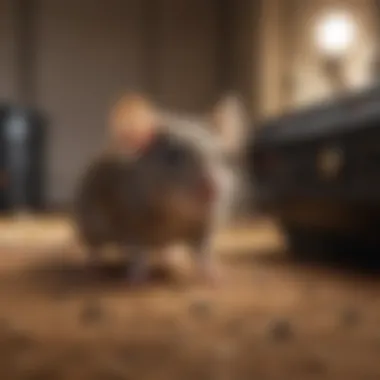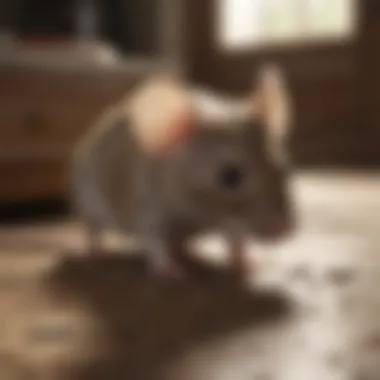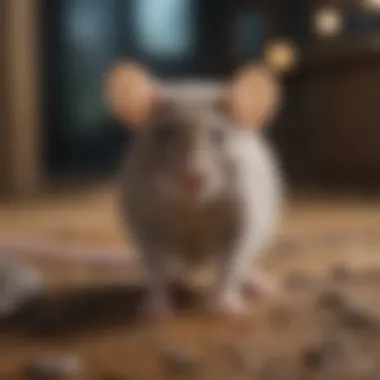Effective Strategies for Managing Mouse Infestations


Intro
Mouse infestations are a prevalent issue in many households. These small rodents are not just mere nuisances; they can pose health risks and cause significant property damage. Understanding their behaviors and habits is crucial for effectively managing and preventing infestations. This guide will equip readers with knowledge about identification, effective prevention techniques, and humane removal methods.
Animal Profile
General Overview
Mice belong to the family Muridae and are often characterized by their small size, pointed snouts, and long tails. The common house mouse, Mus musculus, is the most frequently encountered species in residential areas. These rodents are highly adaptable and can thrive in various environments, ranging from rural fields to urban dwellings.
Habitat and Distribution
Mice are native to most parts of the world, with the exception of extreme climates. They prefer habitats that provide shelter and access to food. In urban settings, they tend to occupy spaces like walls, attics, and basements. Their adaptability allows them to survive indoors, making human dwellings an appealing environment.
Fascinating Facts
Unique Traits and Adaptations
Mice possess several unique traits that aid in their survival. They have a high metabolism and can consume food in small amounts frequently. Their keen sense of smell helps in locating food sources. Furthermore, mice can reproduce rapidly, with females capable of having multiple litters each year, significantly increasing population size.
Historical and Cultural Significance
Throughout history, mice have been present in human society, often depicted in folklore and literature. They symbolize both resourcefulness and pests. The domestication of mice for scientific research has also contributed to their significance in biomedical studies, enhancing our understanding of genetics and disease.
Conservation Status
Current Population Trends
While mice are abundant, urbanization and changes in agricultural practices have affected their populations. The surge in pesticides and habitat destruction has also played a role in their dynamics. Currently, the house mouse population remains stable, as they have effectively adapted to human environments.
Threats and Challenges
Despite their resilience, mice face certain threats. Chemical poisoning and predation from larger animals can impact their numbers. Additionally, public health initiatives targeting pest control can also affect local populations, creating challenges for their survival in some regions.
Care Tips for Pet Owners
Basic Needs and Requirements
For those considering keeping mice as pets, understanding their needs is essential. Mice require appropriate living conditions, such as a spacious cage, bedding material, and social interaction. A balanced diet rich in grains, fruits, and vegetables promotes their health.
Health and Wellness Tips
Maintaining a hygienic environment is critical for pet mice. Regular cleaning of their living space prevents diseases and promotes well-being. Monitoring for signs of illness, such as lethargy or changes in eating habits, ensures early intervention and care.
"Mice serve as both a significant model organism in research and a common household pest, highlighting their dual role in human society."
Understanding the ecology and behavior of mice can enhance our approach to addressing infestations. By exploring the methods of identification and prevention, this guide aims to equip individuals not only with immediate solutions but also with sustainable strategies for a mouse-free environment.
Understanding the Mouse Problem
Understanding the problem of mouse infestations is critical for managing these unwelcome guests in our homes. Mice are more than just a nuisance; they can cause significant damage and pose serious health risks. Comprehending specific elements involved in mouse behavior and tendencies allows homeowners to develop effective strategies for control and prevention. Further, addressing the issue in a knowledgeable manner promotes a sense of empowerment over the pest problem, rather than reliance on reactive measures alone.
Types of Mice Commonly Found in Homes
The most common types of mice found in residential areas include the house mouse, deer mouse, and field mouse. The house mouse is small and typically gray or brown, often nesting indoors. The deer mouse, brown with a white underbelly, is more common in rural areas and can carry hantavirus. Finally, the field mouse prefers rural settings but may venture into homes. Each of these species exhibits unique behaviors and nesting preferences, which can influence management strategies.
Why Mice Enter Our Homes
Mice are attracted to our homes for several reasons. Food availability tops the list, as these rodents are opportunistic feeders. They are also drawn to warmth and shelter, especially during colder months. Any small gaps or holes in walls can serve as entry points, often unnoticed by residents. Additionally, the clutter in homes provides ideal hiding spots for these creatures. Recognizing why mice seek shelter in our living spaces is essential for pro-active prevention measures.
Health Risks Associated with Mice


Mice are carriers of various diseases that can impact human health. One notable example is lymphocytic choriomeningitis (LCMV), which can affect both neurological and reproductive health. Other risks include hantavirus pulmonary syndrome and salmonella, which can cause severe gastrointestinal issues. Furthermore, mice can carry parasites like fleas and ticks, which may introduce additional health hazards. Awareness of these health risks underscores the importance of addressing infestations quickly and effectively.
"Understanding the varied risks associated with mice can help prioritize effective pest management strategies."
Identifying Signs of Mouse Infestation
Identifying signs of a mouse infestation is crucial for effective management and prevention. Early detection enables homeowners to mitigate potential damage and health risks associated with these rodents. By understanding the key indicators that mice leave behind, one can act promptly, reducing the likelihood of larger populations establishing in the home. Awareness of specific behaviors and signs helps in distinguishing actual infestations from false alarms, which can save time and resources.
Common Signs of Mice in Your Home
Mice are secretive creatures, and their presence often goes unnoticed until the problem escalates. Here are some common signs that indicate their presence:
- Droppings: Mice tend to leave small, dark droppings, often found near food sources or nesting areas. The size of the droppings is roughly similar to that of a grain of rice.
- Gnaw Marks: You may see bite marks on wood, plastic, or even cardboard. Mice gnaw to keep their teeth from growing too long, so frequent damage can be a strong sign.
- Nests: Mice build nests from shredded paper, cloth, or insulation. If you find these materials tucked away in corners, it can indicate a mouse home nearby.
- Tracks and Smudges: Mice often leave oily smudges along walls and furniture due to their fur. You can also look for footprints or tail marks in dusty areas.
- Noises: Sounds of squeaking, scratching, or scurrying, especially at night, may indicate mice in your home.
Distinguishing Between Rodent Species
Understanding different rodent species is important for effective treatment. While mice are common pests, other rodents, like rats, may cause similar signs but require different approaches. Mice are typically smaller than rats, with an average length of about 2.5 to 4 inches, excluding the tail. Their droppings also differ in size and shape, which can be a useful identifier. Observing behavior patterns, such as nesting sites or food preferences, can enhance species identification.
Using Tools for Detection
There are various tools available to help detect mouse activity. Some practical options include:
- Mouse Traps: Traditional snap traps can show evidence of activity if bait is taken or if mice are caught.
- Glue Boards: These provide a non-lethal method for catching mice and can help indicate where they are most active.
- Camera Monitoring: Setting up motion-activated cameras can give you insight about the presence and behavior of rodents in real time.
- Tracking Powder: This is a fine dust that can be sprinkled in suspected areas. Mice that pass through it will leave footprints, confirming their path.
Regular inspection and use of detection tools are essential for effective mouse management.
Identifying the signs of mouse infestations ensures that homeowners can respond appropriately, creating a stable environment. Awareness of mouse behavior, coupled with diligent monitoring and recognition of the signs, sets the groundwork for a successful approach to pest management.
Initial Steps to Take
In confronting the issue of mice in residential spaces, initial steps are critical. Recognizing the problem early can help mitigate damage and prevent larger infestations. Therefore, waving off this stage may lead to compounded issues that complicate responses later. Taking the right actions from the outset sets a solid foundation for effective mouse management.
Assessing the Severity of the Problem
Before diving into any pest control strategies, assessing the severity of the mouse problem is essential. Begin by observing your living space for signs of mice, such as droppings or gnaw marks. It is crucial to determine whether the signs indicate a recent or ongoing infestation. Look into places like the kitchen, pantry, and storage areas since these locations often attract these rodents due to available food sources.
You can also perform a thorough inspection at night when mice are typically more active. This time frame can provide a better idea of their presence and habits in your home. If you find nests or numerous droppings, it signals a larger issue. After collecting your observations, quantifying the level of infestation can guide further actions. It might be beneficial to keep a record of what you observe, as this information can help inform any professional consultation, should that become necessary.
Establishing a Plan of Action
After assessing the severity, the next step involves establishing a clear plan of action. An effective action plan starts with prioritizing tasks based on the severity and signs identified. You might need to seal entry points, remove food sources, and set traps if the problem is extensive. Identify the areas where you've seen activity and outline strategic responses for each.
Creating a timeline is also essential. Decide which steps to implement first and set deadlines for their completion. Being organized will facilitate your efforts and lead to quicker resolution. It's also advisable to incorporate preventive measures in this plan. For example, once you address the current infestation, include methods for monitoring the environment regularly.
In addition, having a clear understanding of external help can facilitate decision-making. If the situation escalates beyond personal handling, having contacts for professional pest control services should be part of your strategy. Overall, a well-structured plan ensures that subsequent steps are logical and effective, creating a pathway toward resolution.
"Understanding the initial stages of a mouse infestation is as vital as employing removal strategies."
Preventive Measures
Preventive measures are vital in addressing mouse infestations effectively. Understanding how to keep mice out of your home is essential to avoid the inconveniences of dealing with an infestation. Mice are not just a nuisance; they can cause significant damage to property and pose health risks. Therefore, implementing strong preventive strategies can save time and resources in the future.
Sealing Entry Points
Identifying and sealing entry points is a crucial step. Mice can fit through very small openings. Even gaps as tiny as a dime can serve as an invitation. Inspect your home thoroughly for cracks and holes, especially in areas around pipes, vents, and windows.
Here are some common materials to use for sealing:
- Steel wool: Mice cannot chew through steel wool.
- Caulk: Good for sealing gaps in walls.
- Foam insulation: Useful for larger openings.
By closing these entries, you make it much harder for mice to access your home.


Cleaning and Organizing Your Space
A clean environment minimizes attracting mice. Food sources, such as crumbs and spills, invite rodents into your home. Regular cleaning is essential. Wipe down kitchen surfaces and floors frequently. Store food in tightly sealed containers.
Additionally, decluttering is important. Mice thrive in disorganized spaces where they can hide and nest. Keep storage areas tidy, and minimize cardboard boxes, as mice can chew through them easily.
Here are some effective cleaning and organizing tips:
- Vacuum regularly: Focus on areas like under appliances.
- Dispose of trash promptly: Use trash cans with tightly fitting lids.
- Review storage areas: Ensure they are free of food debris or items that can serve as nesting materials.
Utilizing Natural Deterrents
Natural deterrents can complement physical barriers and cleaning measures. Some scents repel mice, making the environment less welcoming. Essential oils, such as peppermint or eucalyptus, can deter mice effectively. Spraying a mixture of these oils in areas mice frequent can help keep them away.
You might consider using:
- Cotton balls soaked in essential oils: Place them in areas mouse activity is suspected.
- Vinegar: Its strong smell can deter mice.
Implementing these natural methods, alongside conventional strategies, creates a more comprehensive prevention plan.
Conclusion: Preventive measures not only deter mice but also protect your home from potential health risks and damages. Adhering to these strategies will create an environment that is decidedly less hospitable to these unwelcome guests.
Humane Removal Techniques
Humane removal techniques are essential in addressing mouse infestations, particularly for those concerned about animal welfare. Utilizing strategies that avoid harm to the mice aligns with an ethical approach to pest management. These methods not only alleviate the immediate problem but also foster a compassionate relationship between humans and wildlife.
An understanding of humane methods highlights the importance of considering alternatives to lethal measures. Many people find live trapping to be a preferable option. This method allows for the capture of mice without causing injury. Once captured, mice can be released safely away from residential areas.
The benefits of humane techniques include:
- Ethical Considerations: These methods minimize suffering and respect the life of the animal.
- Environmental Impact: Non-lethal methods often have a reduced impact on local ecosystems compared to chemical control.
- Community Relations: A humane approach may encourage neighborhood harmony, as not all residents endorse lethal options.
Factors to consider include the potential stress on the animal during capture and transportation. It's vital to use appropriate methods and follow guidelines to ensure the mice's well-being.
Live Trapping Methods
Live trapping methods are one of the primary humane strategies for mouse removal. These traps allow for the capture of mice without causing harm. Various types of live traps are available, including:
- Box Traps: These traps feature a simple design and are effective for small mice populations.
- Wire Traps: These designs allow for increased ventilation and visibility, which can reduce stress for the captured mice.
- Plastic Traps: Often easier to clean and can be reused.
When setting up live traps, location matters. Ideal placements include areas where signs of activity are evident, such as droppings or nests. Additionally, baiting the traps with attractive food items like peanut butter can enhance effectiveness. It is essential to check traps regularly to minimize the duration the mouse spends inside them.
Safe Release Strategies
Once mice are captured, the next step is safe release. Selecting an appropriate release site is critical. The location should be at least one mile away from the capture site to prevent the mice from returning. Open areas away from human dwellings are preferred, as they provide natural habitats and lessen human interactions.
Before release, consider:
- Time of Day: Early morning or late evening may be best to reduce predation risk.
- Weather Conditions: Ensure that the weather is mild and not extreme to prevent unnecessary suffering.
- Observation: Monitor the mice to ensure they adapt to their new environment.
It’s essential to handle the traps with care to avoid harming the captured mice. Gloves can be used to prevent human scent from transferring to the traps, which may deter the mice when released.
When to Contact Professionals
In some situations, individuals may find it challenging to manage a mouse infestation despite using humane techniques. Signs that it is time to contact professionals include:
- Large Populations: If attempts to use live traps are not successful, a larger infestation may require expert intervention.
- Persistent Issues: Continuous sightings despite all removal efforts might indicate deeper issues or nest locations that need addressing.
- Health Concerns: Hazards associated with the infestation, such as droppings or damage to property, may necessitate professional help.
Professional pest control services can provide specialized knowledge and equipment. These experts may offer a balanced approach that incorporates humane strategies with the necessary urgency.
Choosing humane removal techniques not only resolves the issue of mouse infestations but also reflects a commitment to ethical wildlife management.


Chemical Control Options
Chemical control options play a significant role in addressing mouse infestations. While non-chemical methods like preventive measures and humane removal strategies are vital, there are instances where chemical solutions become necessary. The use of chemicals should be approached with caution and a thorough understanding of the products involved. This section discusses the essential aspects of rodenticides and the safe application of these substances to ensure effectiveness while minimizing risks to people, pets, and the environment.
Understanding Rodenticides
Rodenticides are chemical agents specifically designed to control rodent populations. These products are effective in managing mouse infestations when other methods may not suffice. There are various types of rodenticides available, broadly classified into two categories:
- Anticoagulants: These compounds work by preventing blood clotting, leading to internal bleeding over time. Common examples include bromadiolone and brodifacoum. They often require multiple feedings, making the rodents return for more, which can be an advantage for long-term control.
- Non-anticoagulants: These agents act more quickly, causing death within hours of ingestion. Examples include bromethalin and cholecalciferol. They are typically single-feed baits, meaning that rodents only need to consume a small quantity to have a fatal effect.
Understanding how these chemicals work helps users choose the right product for their specific situation. It is also important to account for the potential health risks to non-target species and humans, which can arise from improper use.
Applying Chemicals Safely
When utilizing rodenticides, safety must be a priority. There are several guidelines to ensure that chemicals are applied correctly and safely:
- Read Labels: Before purchase and application, carefully read the product label. It contains vital safety guidelines, recommended application methods, and information about potential hazards.
- Use Protective Gear: It is advisable to use gloves and, if needed, masks when handling any chemical products to prevent skin contact and inhalation.
- Placement: Ensure that bait stations are placed in areas inaccessible to children and pets. Secure them in locations where mice are active but not reachable by non-target animals.
- Monitor Activity: After placing the rodenticides, monitor the area regularly. This will help assess the effectiveness of the control measures and ensure that no unintended consequences occur.
- Disposal: Dispose of any unused product and dead rodents properly, following local regulations to prevent environmental harm.
Taking these precautions will help create a safer application process for everyone involved, resulting in effective rodent control with minimal risk.
Long-term Solutions and Maintenance
Long-term solutions and maintenance play a crucial role in effectively managing mouse infestations. To ensure that your home remains free from mice, ongoing attention is necessary. Preventive measures are not only about eliminating the current problem but also about creating an environment that discourages future infestations. Without these efforts, homes may invite recurring issues, leading to more significant problems down the line.
Benefits of focusing on long-term strategies include:
- Sustained Prevention: Consistent practices can significantly reduce the likelihood of future infestations.
- Cost-Efficiency: Addressing the problem early and maintaining diligence can save on potential repair and extermination costs.
- Health Safety: Ongoing vigilance helps in keeping pathogens and allergens associated with rodent presence at bay.
- Community Impact: Stronger community efforts can lead to better overall environmental health, affecting wider areas than individual homes.
In addition to these benefits, considerations such as adaptation of strategies to seasonal changes, local wildlife behavior, and personal circumstances play important roles in maintenance efforts. Individuals must remain flexible and informed about the ever-evolving dynamics of pest control.
Regular Monitoring Practices
Regular monitoring is a fundamental aspect of maintaining a mouse-free environment. This involves routine inspections and awareness of changes within your household. Significantly, monitoring helps identify early signs of mice before they escalate into serious infestations. Here are some essential components:
- Routine Inspections: Conduct weekly examinations of your home for droppings, gnaw marks, and signs of nesting. Pay attention to both the interior and exterior areas, especially near entry points.
- Use of Technology: Consider using monitoring devices such as motion-activated cameras or traps that notify you of rodent activity. This can enhance your proactive measures.
- Record Keeping: Maintain a log of any sightings or signs of pests. This will help in identifying patterns and choosing the right strategies for your situation.
This method not only aids in early detection but also supports informed decision-making when it comes to pest control measures.
Community Engagement and Education
Community engagement and education are integral to addressing mouse infestations on a larger scale. A collective approach fosters awareness and fosters more robust community-wide tactics. Here are ways to enhance community efforts:
- Educational Workshops: Organize sessions that teach residents about effective mouse management strategies. These can cover topics from prevention methods to humane removal techniques.
- Neighborhood Monitoring Programs: Encourage volunteer groups to keep an eye out for signs of rodent activities and report back. This can lead to timely mitigation.
- Resource Sharing: Distribute materials such as pamphlets or checklists about keeping homes mouse-free. Sharing knowledge increases the overall efficacy of community efforts.
Engaging with the community not only raises awareness but also fosters a sense of shared responsibility in wildlife management. By combining individual efforts with collective awareness, neighborhoods can effectively reduce mouse populations and promote a healthier living environment.
Final Thoughts
Addressing mouse infestations is not only about immediate action but also involves a strategic long-term approach. This section emphasizes the importance of reflecting on what has been learned throughout the article. Understanding and acknowledging the various aspects that contribute to mouse issues in homes is crucial for effective management.
Evaluating Your Situation
Before implementing any solution, it is essential to evaluate the specific circumstances of your mouse infestation. Consider factors like the severity of the problem and the environment of your home. Are there entry points? Is your living space cluttered? These questions shape your approach and response.
- Assess Entry Points: Identify how mice are entering your home. Check for cracks and gaps, especially in areas near utility lines and vents.
- Inspect Surroundings: Analyze the immediate area for food sources. Garbage bins, pet food, and exposed food can attract mice.
- Observe Behavior: If you have already identified mouse activity, keep track of where you have seen droppings or chew marks. This gives insight into their patterns.
Making a thorough evaluation can help prevent future infestations and set a foundation for an effective plan.
Creating an Actionable Plan
Once you evaluate your situation, the next step is to formulate a sound plan. This plan should be adaptable but comprehensive to address both immediate issues and long-term prevention.
- Set Prioritization: Determine which steps to take first based on the severity of the infestation.
- Establish a Cleaning Routine: Regularly cleaning areas prone to mouse activity will minimize attractants. Implement a daily or weekly cleaning schedule.
- Implement Preventive Measures: After addressing the current pest situation, focus on sealing identified entry points and removing possible food sources. Consider using natural deterrents as part of your strategy.
- Engage Professionals if Needed: If the problem persists or escalates, consider contacting pest control services. They can provide targeted solutions based on their expertise.
When creating your plan, remember it is not a one-time effort but an ongoing process. Staying vigilant will ensure that mice do not return.
Understanding the mouse problem requires constant attention and adaptive strategies. This ensures a safe environment for all inhabitants in the home.















